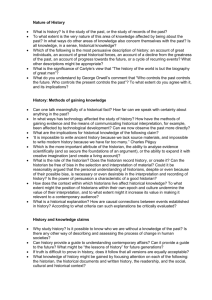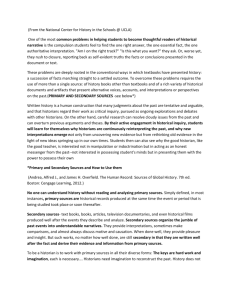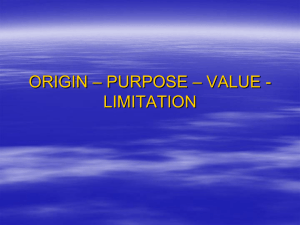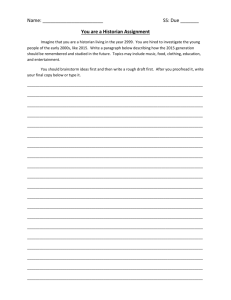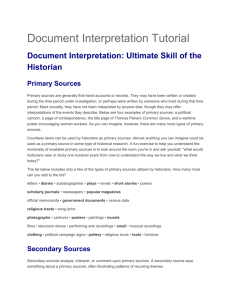File
advertisement
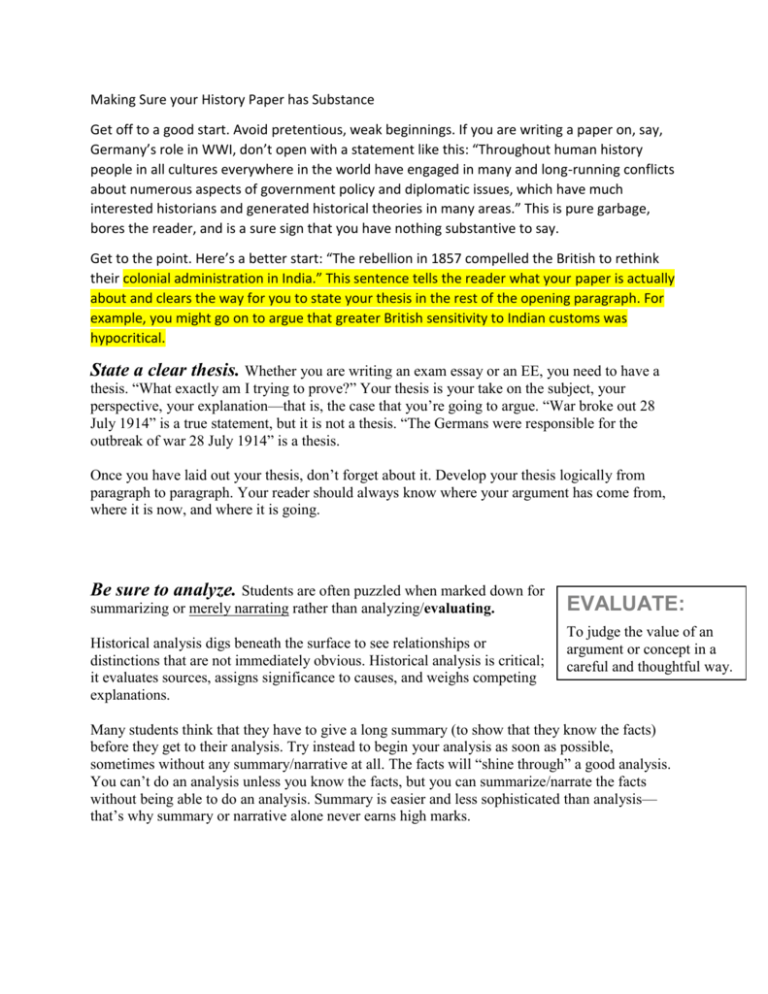
Making Sure your History Paper has Substance Get off to a good start. Avoid pretentious, weak beginnings. If you are writing a paper on, say, Germany’s role in WWI, don’t open with a statement like this: “Throughout human history people in all cultures everywhere in the world have engaged in many and long-running conflicts about numerous aspects of government policy and diplomatic issues, which have much interested historians and generated historical theories in many areas.” This is pure garbage, bores the reader, and is a sure sign that you have nothing substantive to say. Get to the point. Here’s a better start: “The rebellion in 1857 compelled the British to rethink their colonial administration in India.” This sentence tells the reader what your paper is actually about and clears the way for you to state your thesis in the rest of the opening paragraph. For example, you might go on to argue that greater British sensitivity to Indian customs was hypocritical. State a clear thesis. Whether you are writing an exam essay or an EE, you need to have a thesis. “What exactly am I trying to prove?” Your thesis is your take on the subject, your perspective, your explanation—that is, the case that you’re going to argue. “War broke out 28 July 1914” is a true statement, but it is not a thesis. “The Germans were responsible for the outbreak of war 28 July 1914” is a thesis. Once you have laid out your thesis, don’t forget about it. Develop your thesis logically from paragraph to paragraph. Your reader should always know where your argument has come from, where it is now, and where it is going. Be sure to analyze. Students are often puzzled when marked down for summarizing or merely narrating rather than analyzing/evaluating. Historical analysis digs beneath the surface to see relationships or distinctions that are not immediately obvious. Historical analysis is critical; it evaluates sources, assigns significance to causes, and weighs competing explanations. EVALUATE: To judge the value of an argument or concept in a careful and thoughtful way. Many students think that they have to give a long summary (to show that they know the facts) before they get to their analysis. Try instead to begin your analysis as soon as possible, sometimes without any summary/narrative at all. The facts will “shine through” a good analysis. You can’t do an analysis unless you know the facts, but you can summarize/narrate the facts without being able to do an analysis. Summary is easier and less sophisticated than analysis— that’s why summary or narrative alone never earns high marks. Use evidence critically. Like good detectives, historians are critical of their sources and crosscheck them for reliability. You wouldn’t think much of a historian who relied solely on the French to explain the origins of World War I. Consider the following two statements on the origin of World War I: 1) “For the catastrophe of 1914 the Germans are responsible. Only a professional liar would deny this...” 2) “It is not true that Germany is guilty of having caused this war. Neither the people, the government, nor the Kaiserwanted war....” They can’t both be right, so you have to do some detective work. As always, the best approach is to ask: Who wrote the source? Why? When? Under what circumstances? For whom? The first statement comes from a book by the French politician Georges Clemenceau, which he wrote in 1929 at the very end of his life. In 1871, Clemenceau had vowed revenge against Germany for its defeat of France in the FrancoPrussian War. As premier of France from 1917 to 1920, he represented France at the Paris Peace Conference in 1919. He was obviously not a neutral observer. The second statement comes from a manifesto published by ninety-three prominent German intellectuals in the fall of 1914. They were defending Germany against charges of aggression and brutality. They too were obviously not disinterested observers. Now, rarely do you encounter such extreme bias and passionate disagreement, but the principle of criticizing and cross-checking sources always applies. In general, the more sources you can use, and the more varied they are, the more likely you are to make a sound historical judgement, especially when passions and self-interests are engaged. You need to be critical and skeptical. Competent historians may offer different interpretations of the same evidence or choose to stress different evidence. You will not find a single historical Truth with a capital “T” on any matter of significance. You can, however, learn to discriminate among conflicting interpretations, not all of which are created equal. Think of “NOPVL” . Be precise. Vague statements and empty generalizations suggest that you haven’t put in the time to learn the material. Consider these two sentences: “During the French Revolution, the government was overthrown by the people. The Revolution is important because it shows that people need freedom.” What people? Landless peasants? Urban journeymen? Wealthy lawyers? Which government? When? How? Who exactly needed freedom, and what did they mean by freedom? Here is a more precise statement about the French Revolution: “Threatened by rising prices and food shortages in 1793, the Parisian sans-culottes pressured the Convention to institute price controls.” This statement is more limited than the grandiose generalizations about the Revolution, but unlike them, it can open the door to a real analysis of the Revolution. Be careful when you use grand abstractions like people, society, freedom, and government. Always pay attention to cause and effect. Abstractions (ideas) do not cause or need anything; particular people or particular groups of people cause or need things. Watch the chronology. Anchor your thesis in a clear chronological framework and don’t jump around confusingly. Take care to avoid both anachronisms and vagueness about dates. Anachronism 1. something or someone that is not in its correct historical or chronological time, especially a thing or person that belongs to an earlier time: (oxforddictionaries.com) Use primary sources. Use as many primary sources as possible in your paper. A primary source is one produced by a participant in or witness of the events you are writing about. A primary source allows the historian to see the past through the eyes of direct participants. Some common primary sources are letters, diaries, memoirs, speeches, church records, newspaper articles, and government documents of all kinds. The genre “government records” is probably the single richest trove for the historian and includes everything from criminal court records, to tax lists, to census data, to parliamentary debates, to international treaties—indeed, any records generated by governments. If you’re writing about culture, primary sources may include works of art or literature, as well as philosophical tracts or scientific treatises. Not all primary sources are written. Buildings, monuments, clothes, home furnishings, photographs, religious relics, musical recordings, or oral reminiscences can all be primary sources if you use them as historical clues. The interests of historians are so broad that virtually anything can be a primary source. Use primary sources. Use as many primary sources as possible in your paper. A primary source is one produced by a participant in or witness of the events you are writing about. A primary source allows the historian to see the past through the eyes of direct participants. Some common primary sources are letters, diaries, memoirs, speeches, church records, newspaper articles, and government documents of all kinds. The capacious genre “government records” is probably the single richest trove for the historian and includes everything from criminal court records, to tax lists, to census data, to parliamentary debates, to international treaties—indeed, any records generated by governments. If you’re writing about culture, primary sources may include works of art or literature, as well as philosophical tracts or scientific treatises—anything that comes under the broad rubric of culture. Not all primary sources are written. Buildings, monuments, clothes, home furnishings, photographs, religious relics, musical recordings, or oral reminiscences can all be primary sources if you use them as historical clues. The interests of historians are so broad that virtually anything can be a primary source. Use scholarly secondary sources. A secondary source is one written by a later historian who had no part in what he or she is writing about. (In the rare cases when the historian was a participant in the events, then the work—or at least part of it—is a primary source.) Historians read secondary sources to learn about how scholars have interpreted the past. Just as you must be critical of primary sources, so too you must be critical of secondary sources. You must be especially careful to distinguish between scholarly and non-scholarly secondary sources. Unlike, say, nuclear physics, history attracts many amateurs. Books and articles about war, great individuals, and everyday material life dominate popular history. Who is the author? Most scholarly works are written by professional historians (usually professors) who have advanced training in the area they are writing about. If the author is a journalist or someone with no special historical training, be careful. Who publishes the work? Scholarly books come from university presses and from a handful of commercial presses. If it’s an article, where does it appear? What do the notes and bibliography look like? If they are thin or nonexistent, be careful. Can you find reviews of the book in the data base Academic Search Premier? If the book was Contingency is key to historical thinking and helping students understand that while in hindsight, the past seems to unroll in logical storylines, this was not necessarily the case for those who lived through it. If suffragettes hadn't taken to the streets in the 1910s or focused on changing state laws, would they have won the vote in 1920? If the Treaty of Versailles contained different stipulations, would Germany have taken the path it did and would WWII have happened? Historical events are dependent (or contingent) on multiple causes that shape when, how, and why an event happened the way it did.



